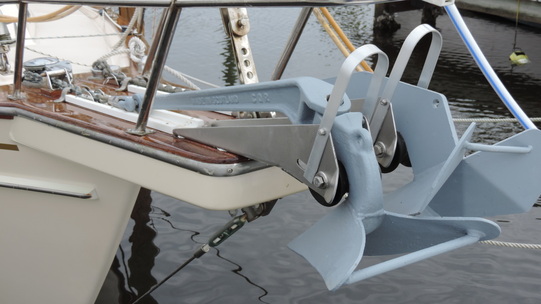The Foredeck and Anchoring
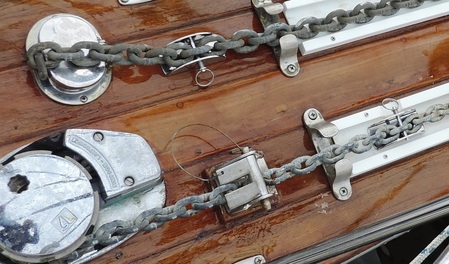
The foredeck and ground tackle were key items when selecting the boat because of our desire to anchor out.
- The anchor had to be ready to deploy quickly should we lose control of the boat in a confined area.
- A raised area around the toe rail to ensure footing and handrails for a good hold is a necessity.
- An electric windless for raising anchor is the only option.
- A down button was added to the electric windless, because in heavy seas the chain landed on top of itself by the boat motion. This made it impossible to get the chain to pay out. This required a trip from the foredeck down through the boat to the chain locker just to flip the chain loose. Again, we did not want this time-consuming step should the boat be out of control in a confined area. When you are coming to a stop, you are out of control.
- Anchors out on the bow pulpit are ready to deploy. Here again if the anchor was stored below deck or in a compartment, it would add to the stress of getting the boat under control in a tight area.
- One good anchor should do the job. In this Boater's opinion, the second anchor is just for backup. Two anchors down on the bow is just a tangle waiting to happen.
Anchoring
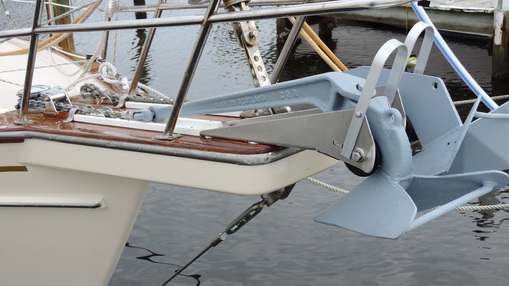
- Dropping the anchor. First, remove your tie downs or pins to free your anchor. Loosen the clutch on the windless as this will let the chain out freely. At this point you may need to give the anchor a shove to let it drop. You should have come to a stop by now, and being blown down by the wind or backing down at idle. Let the chain come out until you have a 7 to 1 scope. You should be able to tell this by markers you have placed on your chain. Do not forget to consider the bows height above the water in calculating your scope.
- Anchor holding. When you have your desired scope, tighten your windless clutch and set your chain lock. You can tell if the anchors holding when the bow heads up into the wind because you have been blown sideways by now. In addition, if you can feel your chain bouncing, the anchor is dragging and you may need more scope or a retry. Once you feel no bounce and the chain seems tight, back down with the engine at about 1000 RPMs. This should set the anchor and pull the chain nice and tight. You might feel the bow dip slightly.
- Leave your chart plotter tracking your movements, and you can be confident of your anchorage. Setting an anchor drag alarm is also a good idea.
- Raising the anchor. Flip your chain lock to free the chain and remove any snuber you may have placed. Ensure that your windless clutch is tigh. and your winch handle is removed. Raise the anchor. Bring the chain in until it's tight. Let the weight of the chain bring the boat forward. When you have some slack, bring the chain tight again. Do this in steps until you've raised the anchor. This saves your windless motor. Also, if it's choppy, and your bouncing only bring in the chain when the bow is down and you have slack. Otherwise, the load may blow the circuit breaker.
- Secure your anchor.
- Guardrails over the bow rollers prevent the anchor from jumping off the bow rollers. When the anchor is raised and comes up over the roller, the leverage can flip the anchor up and out of the bow rollers. Once the anchor is off the rollers, it's heavy and awkward to get back into place, especially with a pitching deck.
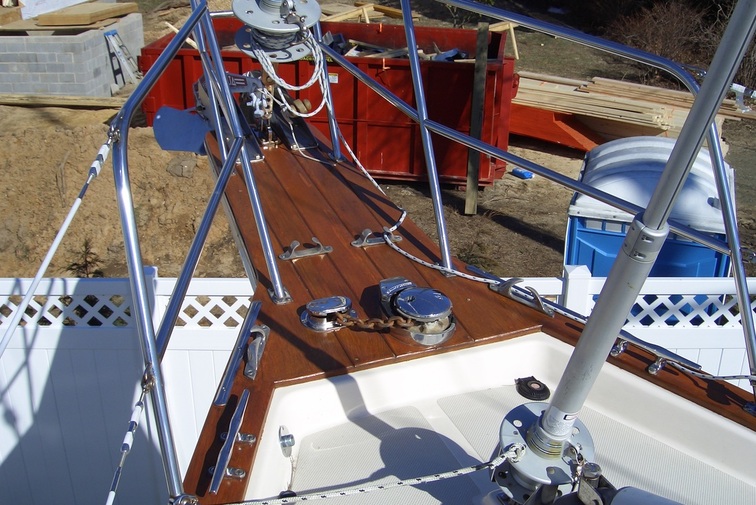
FOREDECK IMPROVEMENTS Before and After
The Bow 2005 Before Picture
The Bow 2005 Before Picture
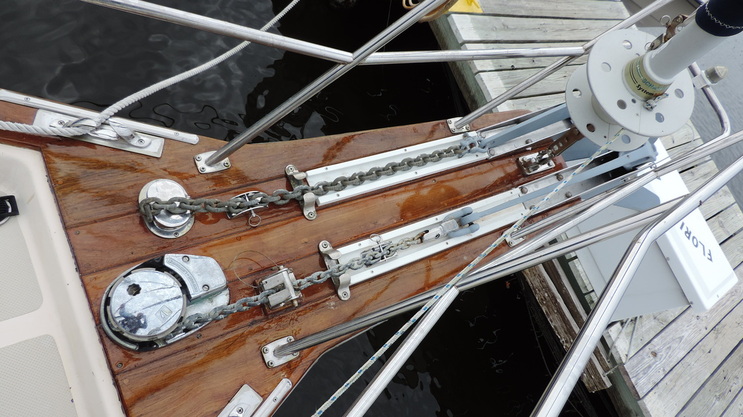
The Bow 2014
Note the starboard chain has chain lock in front of the windless. This locks the chain at anchor taking the load off the windless.
In front of the chain lock you see a pin through the chain to hold the anchor in place when not in use. The chain pin can be seen on the Port chain even better.
For rough weather anchoring a nylon snubber line is run from a cheat on the bow over the bow roller making a slack loop in the chain. The nylon line provides the stretch to take up the shock of tugging chain.
Note the starboard chain has chain lock in front of the windless. This locks the chain at anchor taking the load off the windless.
In front of the chain lock you see a pin through the chain to hold the anchor in place when not in use. The chain pin can be seen on the Port chain even better.
For rough weather anchoring a nylon snubber line is run from a cheat on the bow over the bow roller making a slack loop in the chain. The nylon line provides the stretch to take up the shock of tugging chain.

Guardrails over the bow rollers prevent the anchor from jumping off the bow rollers. When the anchor is raised and comes up over the roller, the leverage can flip the anchor up and out of the bow rollers. Once the anchor is off the rollers, it's heavy and awkward to get back into place, especially with a pitching deck.
